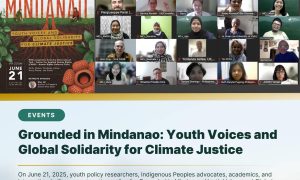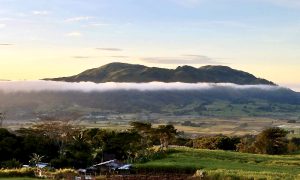Upholding Indigenous Peoples’ Dignity and Defending the Environmental Human Rights Defenders of Mindanao
Final part of the summary of events for Katungod Conference 2025 | Read Part 1 here.
From Memory to Movement
While the morning session of the Katungod Conference commemorated the Talaingod 13 and affirmed solidarity in the face of injustice, the afternoon session widened the lens—revealing that the violence experienced in Talaingod is not isolated.
The session began with a cultural performance led by Fr. Roger from Socsargenic who played the flute in a solemn invocation of the land’s spirit, followed by an upbeat community song that brought energy and unity into the room. His offering honored ancestral traditions while inviting everyone to join in a collective rhythm—grounded in culture, memory, and the continuing journey toward justice.
Testimonies from communities across Mindanao showed that land grabbing, red-tagging, displacement, and ecological destruction continue in many forms. Through shared stories, legal reflection, and symbolic action, the conference deepened its call—not just to stand for the Talaingod 13, but to stand for all defenders of land and life.

Voices from the Ground: Persistent Injustice
The afternoon session opened with testimonies from community representatives across Mindanao, including those from Iligan, Amai Manabilang, Upi (BARMM), two representatives from different communities in Bukidnon, and a youth speaker from Marawi. Though their situations differ, their voices reflected a shared landscape of hardship and resistance.
They spoke of displacement, land conflict, loss of livelihood, and militarization. The criminalization of Indigenous and Moro leaders, the closure of schools, and the threats posed by mining and agribusiness echoed across their stories.
And yet, amid the grief, there was gratitude and hope.
Some shared that this was the first conference they had ever attended—and expressed deep appreciation for the chance to speak, to be heard, and to be part of a broader movement. They acknowledged the risks of telling their stories, yet found strength in the presence of advocates, elders, and fellow youth who stood beside them.
Testimony of Nurainie: Youth from Marawi
Closing the testimonial segment was Nurainie “Ainee” Rakim, a Moro youth from Marawi City and intern of Mindanao Climate Justice. Speaking as an internally displaced person (IDP), she described the long road to recovery after the 2017 Marawi Siege—highlighting the ongoing struggles of those still living in transitional shelters, and the daily barriers to education and rebuilding.
“Ang aming lakas ay nanggagaling sa sama-samang panawagan ng mga IDP—para sa hustisya, katotohanan, at kambalingan.”
Ainee ended with a call for solidarity and long-term support: “Ang pagtulong sa Marawi ay isang pamumuhunan sa kinabukasan ng Mindanao.”
Her closing words brought the testimonial segment to a powerful end—full of clarity, compassion, and conviction.

Atty. Ice Baguilat: The Right to a Healthy Environment
Atty. Raymond Marvic “Ice” Baguilat, Senior Lecturer at the UP College of Law and Head Legal Officer of the UP Law Center’s Institute of Human Rights, delivered the third input of the day—an in-depth reflection on the right to a clean, healthy, and sustainable environment.
Citing international frameworks, constitutional provisions, and legal precedents, he explained that this right is not theoretical—it is recognized by over 160 countries, including the Philippines, and is fundamental to a dignified life. He emphasized that environmental destruction is also a human rights crisis, especially for Indigenous Peoples, women, youth, and the poor.
Among the core principles he outlined:
- Environmental harm must be prevented, not just cleaned up after
- States must protect, respect, and fulfill environmental rights under both domestic and international law
- Legal tools like the Writ of Kalikasan and SLAPP defense provisions must be strengthened and made truly accessible
He stressed the urgency of addressing climate displacement, land grabbing, and development aggression, all of which disproportionately harm marginalized communities.
“The right to a healthy environment is not separate from the right to life, to land, or to dignity. These are deeply connected—and must be defended together.”

After his presentation, the session opened for questions and reflections. Community leaders, youth, and faith workers raised concerns about mining, land rights, state neglect, and legal protections. Atty. Ice responded with clarity and openness, grounding his answers in both law and lived experience. The exchange affirmed the space as not just a forum—but a shared dialogue of rights, resistance, and responsibility.
Launch of the PANAAD Network
The final input of the day was the launch of the PANAAD Network, facilitated by Prof. Mae Fe Ancheta-Templa, Chairperson of Mindanao Climate Justice and former DSWD Undersecretary.
“Panaad” means vow or devotion in Visayan. It is both a promise and a path—of standing with the most marginalized, and journeying toward justice, dignity, and healing.
Prof. Mae Fe explained that the network responds to the growing threats faced by Indigenous, Bangsamoro, and rural communities—from land grabbing to climate disaster, red-tagging to exclusion.
Its vision is a just, peaceful, and sustainable Mindanao, where defenders of land and life are protected and empowered. Its mission: to build a community-rooted, faith-grounded, rights-based alliance that nurtures hope and collective action.
The PANAAD Network is built on four core values:
- Panaad (Devotion)
- Pakigduyog (Accompaniment)
- Pakigdait (Solidarity)
- Pagmugna (Transformation)
And four strategic pillars:
- Community accompaniment and protection
- Education and formation
- Advocacy and legal solidarity
- Faith-based organizing and rituals
“This is our vow. This is our path. Let us walk it together.”
The invitation was clear: the network is open to all who share its vision and are ready to take action.
Reading of the PANAAD Unity Statement and Symbolic Pledging
The reading of the PANAAD Unity Statement was led by Atty. Beverly Musni, a respected human rights lawyer and member of the Union of Peoples’ Lawyers in Mindanao (UPLM). Before reading the statement, she offered a heartfelt message of solidarity with the Talaingod 13, affirming the legal community’s ongoing support for those criminalized for defending education, land, and life.
As Atty. Beverly read the statement aloud, the conveners began writing their personal vows on pieces of paper and hanging them on a symbolic plant placed at the center of the room—turning commitment into ritual.
After the reading, participants were invited to do the same. One by one, they came forward—Lumad elders, youth, Church workers, farmers, and allies—each writing and hanging their own panata onto the plant. It was a quiet and solemn act, but deeply communal. Together, they transformed the space into a living altar of shared promise.
The moment marked not just the launch of a network, but the beginning of a vow kept together.


Closing Message and Community Dance
To close the conference, Mr. Bong Florendo, Coordinator of the Social Action Center (SAC) of the Archdiocese of Cagayan de Oro, delivered the final message. He thanked the participants—Lumad, Moro, and settlers alike—for coming together in courage and in truth.
He acknowledged the pain shared throughout the day, but also affirmed the power of community, faith, and action. In his remarks, Mr. Florendo challenged everyone to carry the spirit of Katungod beyond the walls of the conference hall—into their churches, schools, communities, and everyday lives.

“Our commitment to justice cannot end here. Let us take what we have heard, what we have felt, and let it move us—not just emotionally, but into action.”
Following the message, the gathering moved into a community dance—a final gesture of unity, joy, and collective breath. Participants stood in a circle, moving together in rhythm and reflection. The dance became a closing ritual: a celebration of strength, of presence, and of the vow they now shared.





